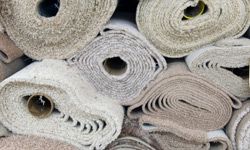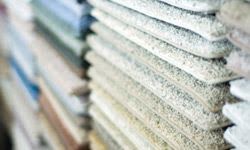Home Improvement

It may surprise you, but you can learn a lot about a carpet from its label.
©iStockphoto.com/Brad Benefield
Installing new carpet can transform a room and leave a lasting impression. However, when you step into a carpet showroom, the number of choices can be overwhelming. Don’t fall for every sales pitch; a little knowledge can go a long way. Before you go shopping, make sure you are prepared.
Once you have settled on a color, you need to decide on the type of fiber material you prefer. Then, you will need to compare the durability tests of different carpets, as well as consider the specific twist and density to predict its longevity. You will also want to investigate the carpet’s stain resistance and any harmful chemical additives.
Thankfully, most of the information you need is available on the carpet label. However, it is essential to understand the jargon and what each detail means for the life of your carpet.
10: Carpet Durability: Twist and Density

Investing in durable carpet can save you money in the long run.
©iStockphoto.com/Brad Benefield
Replacing old carpet can be an expensive and inconvenient process. Therefore, investing in durable carpet is a wise choice. The longer your carpet lasts, the longer you can wait before replacing it, and the more money you can save in the long run.
Durability depends on density and twist, two specifications listed on the label. Density refers to how close together the strands of fiber are, measured in fibers per square inch. Denser carpet lasts longer because it is more resistant to impacts and stains. On the other hand, twist refers to the number of times a strand of fiber is twisted per inch. A carpet with high twist levels is less likely to unravel and more durable. It is essential to note that density and twist should not be confused with face weight, which measures the amount of fiber in ounces per square yard.
9: Standardized Durability Tests

While durability is essential, proper maintenance is also crucial for the longevity of your carpet.
©iStockphoto.com/323 Design
Determining durability can be challenging as it depends on various factors, such as fiber type. However, standardized durability tests can help you compare different carpets. It is crucial to maintain your carpet well to ensure its longevity.
To simplify comparison shopping, standardized durability tests are used and a number on the carpet label can refer to such a test. The Home Depot durability rating system, known as the Performance Appearance Rating (PAR), is endorsed by the Carpet and Rug Institute (CRI) and Consumer Reports. The system uses a walk test to simulate what the carpet will look like after a year of normal traffic by a family of four. Look for a score from 1 to 5 on the label and a high score of 4 or 5 indicates good durability. Other major retailers use similar durability tests, such as Shaw Floors, which uses its own performance rating from 1 to 5. While these ratings systems oversimplify the issue of durability, considering them in conjunction with other specifications like twist and density will help in your decision-making process.
Fiber type is one of the most important aspects of a carpet as it describes what the carpet is made of. There are various options for fiber type, including nylon, polyester, wool, olefin, and acrylic. Nylon is the most popular choice as it is moderately priced, durable, easy to clean, and has decent stain resistance. Polyester is one of the cheapest options, won’t fade in the sunlight, and offers good stain resistance but isn’t very durable. Wool is considered the best quality carpet for appearance and feel but is relatively expensive, fades in direct sunlight, and wears down more easily than some synthetics. Olefin is inexpensive, won’t fade if chemically treated, has great stain resistance, and is comparatively resistant to moisture, mildew, and static. Acrylic looks and feels more like wool than any of the other synthetics but is a little more expensive than nylon and can tend to pill and fuzz.
Stain and soil resistance is also an important factor to consider when purchasing a carpet. Though no carpet is perfect and all spills need prompt attention to keep it clean, some materials and carpet constructions are naturally more stain resistant than others. Companies usually treat carpet with additional chemicals to make it more resistant, so look for carpets that are stain resistant to avoid permanently blemishing your beautiful and expensive carpet.
Teflon and Scotchguard technology allow liquid stains to form beads on fabric surfaces, making them easy to soak up quickly. On the other hand, StainMaster carpets work by neutralizing the electric charge on the fabric. This is important because many commercial food and drink products contain negatively charged dyes, similar to those used in coloring carpets. Without neutralizing the charge, spilled food will attach permanently to the remaining positive charges. Fortunately, you can often find information about stain resistance on the label, including the appropriate stain remover products and maintenance procedures. While some stain-resistant chemicals may wear away over time, they can be reapplied.
In the late 1980s, controversy arose when workers in the EPA headquarters complained of becoming ill from the new carpets. The chemicals applied to carpets during the manufacturing process, including stain resistance, flame retardant, and antimicrobial chemicals, were identified as the culprit. Some of these chemicals, such as 4-phenylcyclohexene responsible for the “new carpet smell,” are suspected of causing sickness, while critics claim that certain carcinogens like formaldehyde, toluene, xylene, and benzene are emitted from carpets. The CRI launched an initiative to reduce the levels of these chemicals and inform consumers about the complaints. Carpets that meet the low-emitting standards set by CRI receive a “Green Label” certification, which consumers can check on the carpet label. Carpets also have the potential to capture particles from the air, such as dust, cleaning products, and toxins dragged in from outside, which can make people sick. To minimize these effects, ventilation and regular cleaning with a heavy-duty vacuum are recommended.
Despite the CRI’s Green Label initiative and precautions consumers can take, controversy remains. Critics argue that the Green Label rating system is not vigorous enough, and some blame Green Label-certified carpets for emitting chemicals that cause health problems. However, the Consumer Product Safety Commission admits that it doesn’t have evidence that carpet chemical emissions cause adverse health effects, and even the EPA states that research hasn’t determined whether carpet chemicals could be responsible. Nevertheless, the EPA recommends taking precautions, such as airing out the carpet for several days before installation and keeping the house well-ventilated for at least a few days after. Low-emitting adhesives can also be requested from the retailer.
4: Carpet R-Value: Keeping the Room Warm
Carpets are preferred over hardwood or vinyl floors because they make a room warmer both literally and figuratively. Carpet provides insulation and can insulate up to 10 times more than hardwood. The R-value of a carpet indicates its thermal resistance rating and can be found on a carpet label. The R-value depends on the carpet’s thickness rather than the fiber type. If the R-value is not available on the label, one can determine it by multiplying the carpet’s thickness in inches by 2.6. To calculate the total insulating value, the thickness of the carpet pad should also be included in the calculation. A carpet’s insulating abilities can save energy costs up to $8,000, and its cost can be recouped in 9 years.
Hot Colors
The color of the carpet is a personal preference, but darker colors absorb and radiate more heat than lighter ones. From a design perspective, darker colors make a room look smaller, while lighter colors make it look bigger.
3: Carpet Construction: Backing and Cut Pile

Tufting is the most common method used for inserting fiber yarn into a backing. A layer of synthetic latex adhesive is used to attach the yarn to a secondary backing. A carpet can also be woven on looms without a secondary backing. Cut pile type is another aspect to consider when choosing a carpet. Frieze is tightly twisted and durable, saxony can vary from smooth to textured appearances, and plush style is level cut and dense.
Loop style is another kind of carpet that uses uncut loops of yarn instead of cut tufts. Loop-pile carpet can be level, multilevel, or a combination of cut and loop. Loop styles are very durable.
2: Other Carpet Label Details

Consumers should pay attention to all the details the manufacturer puts on the label as they can provide significant information about the carpet.
When shopping for carpet, it is important to come prepared with room measurements to ensure that the carpet fits properly. Keep in mind that you may need to order more carpet than the room’s actual size. It is also a good idea to check the label for well-known manufacturer names and research their reputation for quality and user reviews. Labels may also list the carpet collection, which is useful if you want matching carpets in different rooms.
The warranty is an important aspect to consider when purchasing carpet. However, it is important to read the fine print as some warranties may not be as good as they seem. Wear warranties protect against carpet wear, but may have conditions that require a certain percentage of the carpet to be worn before it can be repaired. Stain warranties are also good, but typically have maintenance conditions that must be followed for the warranty to be valid. Carpet shopping requires attention and care, but the advantages of comfort, insulation, and style make it worth it.
Additional Information
Related Articles
- 5 Tips for Selecting Carpet
- Professional Carpet Installation Procedure
- How Stain Resistant Carpet Works
- Top 10 “Don’ts” for Flooring
- Curiosity Project: How Speedily Can Your Floor Materials Regrow?
Sources
- Ashton, Karen, et al. “The Toxic Consumer: Living Healthy in a Hazardous World.” Kensington Publishing Corp., 2008. (Oct. 8, 2010)http://books.google.com/books?id=_5tlcLRXIxgC
- BobVila.com. “Choosing Carpet: What to Look for Before You Buy.” BobVila.com. (Oct. 8, 2010)http://www.bobvila.com/HowTo_Library/Choosing_Carpet_What_to_Look_For_Before_You_Buy-Carpeting-A1554.html
- Carpet Institute. “Thermal Insulation Performance of Carpet.” Carpet Institute of Australia Limited. (Oct. 8, 2010)http://www.carpetinstitute.com.au/downloads/pubs/factsh_thermal.pdf
- Consumer Reports. “Wall-to-wall Carpeting.” Consumer Reports. November, 2007. (Oct. 8, 2010)http://www.consumerreports.org/cro/home-garden/bed-bath/home-decoration/wall-to-wall-carpeting/overview/index.htm
- Cooper, Joe. “Carpet Benefits.” Carpet Buyer’s Handbook. (Oct. 8, 2010)http://www.carpetbuyershandbook.com/buying-carpet/important-buying-info/carpet-benefits.php
- Cooper, Joe. “Carpet Fibers.” Carpet Buyer’s Handbook. (Oct. 8, 2010)http://www.carpetbuyershandbook.com/carpet-basics/construction-fibers/pile-fibers.php
- CPSC. “Tips for Purchasing and Installing New Carpet.” US Consumer Product Safety Commission. (Oct. 8, 2010)http://www.cpsc.gov/cpscpub/pubs/454.html
- CRI. “Commercial Customers: Carpet and Rug Construction: Understanding Carpet Construction.” Carpet and Rug Institute. (Oct. 8, 2010)http://www.carpet-rug.org/commercial-customers/selecting-the-right-carpet/carpet-and-rug-construction.cfm
- CRI. “Understanding Thermal Values (R-Values) of Carpet and Cushion.” Carpet and Rug Institute.http://www.carpet-rug.org/pdf_word_docs/UnderstandingRvalues.pdf
- EPA. “The Inside Story: A Guide to Indoor Air Quality.” Environmental Protection Agency. Last updated Sept. 30, 2010. (Oct. 8, 2010)http://epa.gov/iaq/pubs/insidest.html
- Goddard, Jim. “Carpet Guru’s Carpet College.” CarpetGuru.com. (Oct. 8, 2010)http://www.carpetguru.com/
- Hilton, Michael. “Construction Basics.” The Carpet Buyer’s Handbook. (Oct. 8, 2010)http://www.carpetbuyershandbook.com/carpet-basics/construction-fibers/construction-basics.php
- Hilton, Michael. “Carpet Measuring.” The Carpet Buyer’s Handbook. (Oct. 8, 2010)http://www.carpetbuyershandbook.com/buying-carpet/important-buying-info/carpet-measuring.phplivepage.apple.com
- Hilton, Michael. “Stainmaster Carpet.” The Carpet Buyer’s Handbook. (Oct. 8, 2010)http://www.carpetbuyershandbook.com/carpet-basics/topical-treatments/dupont-stainmaster.php
- Home Depot. “Carpet Buying Guide.” Home Depot. (Oct. 8, 2010)http://www.homedepot.com/webapp/wcs/stores/servlet/ContentView?pn=SV_HS_Carpet_Performance_Durability&langId=-1&storeId=10051&catalogId=1
- Marty, Diane. “Consumer News: Carpet Highs and Whoas.” The Environmental Magazine. Vol. 18, Issue 2. March 1, 2007.
- Shaw Floors. “Comparing Carpet.” Shaw Floors. (Oct. 8, 2010)http://www.shawfloors.com/Tips-Trends/Carpet-Comparing
- ShawMark. “Understanding Carpet Quality.” ShawMark. Shaw Industries. Carpet-USA.org. (Oct. 8, 2010)http://www.carpet-usa.com/bbargain/carpetquality.pdf
- Williams, Rose Marie. “Carpet Politics and Alternatives.” Townsend Letter for Doctors and Patients. BNet. August, 2001. (Oct. 8, 2010)http://findarticles.com/p/articles/mi_m0ISW/is_2001_August/ai_78177235/?tag=content;col1
FAQ
1. What information can I find on a carpet label?
A carpet label provides essential information about the carpet, including the fiber content, the density, the pile height, the tuft twist, and the warranty information.
2. Why is it important to check the fiber content on a carpet label?
The fiber content determines the durability, stain resistance, and maintenance requirements of the carpet. Knowing the fiber content can help you choose the right carpet for your needs.
3. What is carpet density?
Carpet density refers to the amount of fibers per square inch. A denser carpet is typically more durable and resistant to crushing and matting.
4. What does pile height mean on a carpet label?
Pile height refers to the length of the fibers on the carpet. A higher pile height can make the carpet feel more luxurious, but it may be harder to maintain and clean.
5. What is tuft twist on a carpet label?
Tuft twist refers to the number of times the fibers are twisted per inch. A higher tuft twist can make the carpet more durable and resistant to crushing and matting.
6. Can I find information about the carpet’s environmental impact on the label?
Yes, some carpet labels include information about the carpet’s environmental impact, such as whether it is made with recycled materials or if it is certified by a third-party organization for sustainability.
7. How can I use the warranty information on the carpet label?
The warranty information can help you understand what is covered under the warranty and for how long. It can also give you an idea of the expected lifespan of the carpet.
8. Is it important to read the care instructions on a carpet label?
Yes, the care instructions can help you properly maintain and clean the carpet, which can extend its lifespan and keep it looking new for longer.
9. Can I compare carpet labels from different manufacturers?
Yes, comparing the information on carpet labels can help you make an informed decision and choose the best carpet for your needs and budget.
10. What should I do if I have questions about a carpet label?
If you have questions about a carpet label, you can contact the manufacturer or retailer for more information. They should be able to provide you with the answers you need to make an informed decision.

Brody is a skilled craftsman and gardening expert. From renovating living spaces to cultivating lush gardens, Brody’s knowledge and passion shine through, inspiring readers to embark on their own home improvement and gardening journeys with confidence.






Leave a Reply